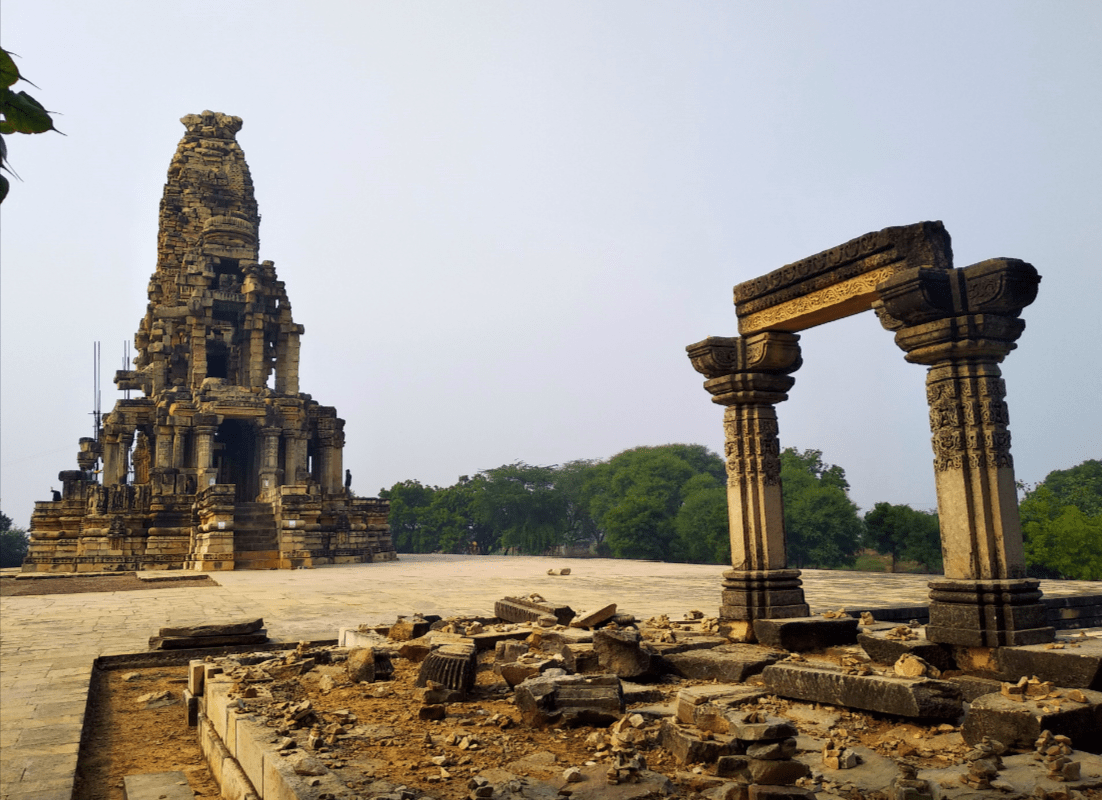Kakanmath Temple: As we traveled along the nearly empty roads winding through the vibrant yellow mustard fields, my gaze was fixated on finding another temple after visiting Mitawali. In the distance, I finally spotted it—Kakanmath Temple, rising majestically amid the golden fields. At first glance, the temple seemed like a massive assembly of stones piled one on top of another, reminiscent of the building blocks we played with as children. The towering structure stood out dramatically against the blue sky, both imposing and captivating. I instantly knew that Kakanmath Temple would be the perfect grand finale to our journey through Morena.
Morena had already amazed us with its rich archaeological treasures. We were captivated by the grandeur of the Bateshwar Temple Complex, the intricate carvings of Padavali, and the understated beauty of the Chausath Yogini Temple. Now, the partially ruined Kakanmath Temple loomed before us, a dominant presence in the landscape.
As you examine it closely, you can’t help but marvel at how such a massive structure still stands. It appears almost as if it’s held together by carefully balanced stones, stacked one atop the other. You might even feel that a strong gust of wind could bring it crashing down. I had the same thought myself. But if it has withstood the test of time for so long, it’s unlikely to crumble now. With that in mind, we climbed the stairs and gazed at the temple, filled with awe and wonder.
A Brief History of Kakanmath Temple
Kakanmath Temple is a significant shrine dedicated to Lord Shiva, located in Sihoniya, about 65 km from Gwalior city. Sihoniya, in the Morena district of Madhya Pradesh, was historically known as Simhapaniya. Historical records suggest that Sihoniya once served as the capital of the Kushawahas of the Kachchhapaghata or Kachwaha Kingdom, which was established around the 11th century. The temple is believed to have been constructed by King Kirtiraj, a Kushawaha ruler, between 1015 and 1035 AD.
An inscription found at the Saas Bahu Temple in Gwalior references a Shiva temple being built at Simhapaniya, which is widely believed to be Kakanmath Temple.
There are two theories about the temple’s name. According to local legend, the temple was built to fulfill the wishes of Queen Kakanwati, and it is said that praying at Kakanmath Temple can make your wishes come true. Another belief is that the temple’s name comes from the words “Kanak” (meaning gold) and “matha” (meaning shrine).
Kakanmath Temple – A Marvel That Defies Gravity
At first glance, Kakanmath Temple’s architecture bears a striking resemblance to the temples of Khajuraho. Many of the sculptures and carvings found here share similarities with those at Khajuraho, suggesting that this was the prevalent style and design of temples during that era. It’s even possible that the renowned Khajuraho temples were inspired by earlier structures like Kakanmath. In fact, a guide at Padavali mentioned that the temples at Padavali were precursors to those at Khajuraho.
Kakanmath Temple rises to an impressive height of 115 feet, featuring a pyramid-like structure. The Mandapa of the temple has two stories, and it’s evident from its remnants that it was once richly adorned. Even in its ruined state, the temple is a magnificent sight. It stands on an intricately carved pitha (raised platform) and is part of a larger complex, with the main temple surrounded by four smaller subsidiary shrines. A pillared corridor leads to the central shrine, which houses a Shiva linga.
From afar, Kakanmath Temple appears as a grand and imposing structure. However, as you approach closer, the intricate carvings on the temple walls become more apparent. The exterior walls are adorned with beautifully sculpted statues, and the pillars are embellished with ornate details. The Sikhara (tower) of the temple rises nearly 30 meters high, showcasing a stunning array of sculptures. We found ourselves mesmerized, admiring the diverse and exquisite carvings that cover the temple.
It feels as though a master sculptor meticulously crafted his masterpiece on the walls, ceilings, and pillars of the Kakanmath Temple.
What amazed me the most was how the temple still stands today. With much of its walls collapsed, Kakanmath now resembles the skeletal remains of a once grand temple. The stones appear precariously stacked, giving the temple a fragile, unsteady appearance.
Interestingly, the temple’s construction didn’t involve any concrete or binding agents—no lime was used. The stones were strategically placed one atop the other, relying solely on their precise positioning to hold the structure together.
While it makes sense that in its prime, with all walls and structures intact, the temple would have been a dominant presence, it’s astounding that it continues to stand even in its ruined state. This speaks volumes about the ingenuity of the architect who designed it and the skill of the craftsmen who carefully placed each stone. One wonders if any modern architect could replicate such a marvel today.
Over time, the temple has suffered significant damage. It is likely that earthquakes and invasions have contributed to its current state of ruin. The grounds around the temple are scattered with sculpted stones and masonry remnants from the temple and its subsidiary shrines. The Sikhara, once adorned with decorative stones, has lost much of its ornamentation. Only the upper story of the central part of the Mandapa, topped with a bell-shaped structure, has managed to endure.
The temple appears as though it could collapse at any moment. Perhaps it’s time for archaeologists to give Kakanmath Temple the attention it deserves. Currently, the temple is under the care of the Archaeological Survey of India (ASI) in Gwalior.
In front of the temple, as you ascend the steps to the raised platform, there is a gate-like structure. Interestingly, this gate is aligned parallel to the temple, which is unusual since such gates are typically positioned perpendicular to the temple, framing the entrance as you approach. It’s possible that this gate originally stood that way but may have collapsed and was later repositioned. I pondered this as I wandered around the temple complex. Nearby, there is a small, broken temple, hinting that there may be more such structures yet to be unearthed.
The ruins of Kakanmath Temple are truly magnificent and awe-inspiring. In a way, the missing outer walls and the crumbling state of the structure add to its majestic appearance. Of course, that’s just my perspective. Visit Kakanmath Temple yourself and share your thoughts on this remarkable site!
The site is still under excavation, with numerous broken pieces of the temple scattered around. I learned that the Archaeological Survey of India (ASI) has been working on restoration efforts for some time now. This temple has stood tall for the past 1,000 years, and I hope it continues to stand just as majestically for the next 1,000 years.
How to Get to Kakanmath Temple?
You can reach Kakanmath Temple from Gwalior via two routes: one through Morena and the other through Malanpur. The route through Morena covers a distance of approximately 70 km from Gwalior to the temple.
The closest railway station to Kakanmath Temple is Morena, where most trains make a stop. From both Morena and Gwalior, buses are available that travel to Sihoniya village. You can take one of these buses to reach the village. However, Kakanmath is located a bit away from the main road, and finding local transport in this area can be challenging.
We explored the archaeological sites in Morena and Kakanmath all in one day. We hired a car from Gwalior and managed to complete the entire trip in a single day. Our journey began in the morning from Gwalior, with our first stop at the Bateshwar Temple complex, followed by visits to Padawali and Mitawali. Kakanmath was our final destination for the day.
We heard that there are several other spots and archaeological attractions in the area, but unfortunately, we couldn’t explore them due to time constraints. However, we definitely plan to return and explore more of what this region has to offer.
Best Time to Visit
Madhya Pradesh experiences an extreme climate, with very hot summers. Therefore, the ideal time to visit these areas is during the winter season. Alternatively, the monsoon season is also a good time to explore.
Accommodation Options
Accommodation in Sihoniya village is limited, so the best option is to stay in Gwalior and plan a day trip to both Morena and Sihoniya. Staying in Morena town is another feasible alternative.



